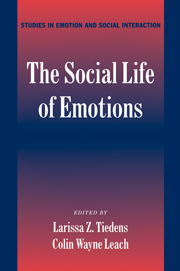Book contents
- Frontmatter
- Contents
- Acknowledgements
- List of Contributors
- The Social Life of Emotions
- Introduction: A World of Emotion
- PART I THE INTERPERSONAL CONTEXT
- 1 Empathy
- 2 Envy and Its Transmutations
- 3 The Bond Threat Sequence
- 4 Emotion as Adaptive Interpersonal Communication
- 5 Does Expressing Emotion Promote Well-Being? It Depends on Relationship Context
- PART II THE INTRAGROUP CONTEXT
- PART III THE INTERGROUP CONTEXT
- Index
- References
1 - Empathy
Negotiating the Border Between Self and Other
Published online by Cambridge University Press: 01 April 2011
- Frontmatter
- Contents
- Acknowledgements
- List of Contributors
- The Social Life of Emotions
- Introduction: A World of Emotion
- PART I THE INTERPERSONAL CONTEXT
- 1 Empathy
- 2 Envy and Its Transmutations
- 3 The Bond Threat Sequence
- 4 Emotion as Adaptive Interpersonal Communication
- 5 Does Expressing Emotion Promote Well-Being? It Depends on Relationship Context
- PART II THE INTRAGROUP CONTEXT
- PART III THE INTERGROUP CONTEXT
- Index
- References
Summary
Self and other. Ego and alter. Ingroup and outgroup. Us and them. Home and visitors. Shirts and skins. Eagles and Rattlers. Klee and Kandinsky. Potter and Malfoy.
As the number and variety of these (and countless other) terms attest, it is absurdly easy to generate ways of thinking about the world that emphasize the separation between self and other. In fact, the point is so obvious as to almost appear self-evident. A quick glance at the morning paper will reveal a depressing number of instances of individuals and groups acting in ways that increase their own welfare at the expense of other individuals or groups. This sad reality is echoed, moreover, in more formal investigations of human nature. Psychology's view of humanity has long included a strong emphasis on hedonism (e.g., Cialdini, Darby, & Vincent, 1973; Dollard & Miller, 1950; Spencer, 1870). In short, the tendency for humans to see their interests as separate from others, and to act so as to maximize their interests at the expense of others, is widespread and robust.
However, the gap between self and other is not unbridgeable. People do not always act in ways that maximize their own self-interest. We are capable of inhibiting our immediate and frequently destructive responses to provocation, and substituting more constructive ones. We can forgive transgressions, even quite serious ones. We often act toward others in friendly ways, and sometimes offer help at great risk to ourselves.
- Type
- Chapter
- Information
- The Social Life of Emotions , pp. 19 - 42Publisher: Cambridge University PressPrint publication year: 2004
References
- 38
- Cited by

